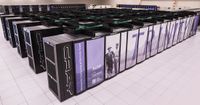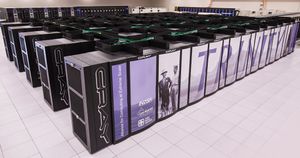From WikiChip
Difference between revisions of "supercomputers/ats-1"
| (4 intermediate revisions by the same user not shown) | |||
| Line 2: | Line 2: | ||
{{supercomputer | {{supercomputer | ||
|name=Trinity | |name=Trinity | ||
| + | |image=ats-1 trinity 2015.jpg | ||
| + | |caption=2015 | ||
|sponsor=U.S. Department of Energy | |sponsor=U.S. Department of Energy | ||
|designer=Intel | |designer=Intel | ||
| Line 13: | Line 15: | ||
|successor link=supercomputers/ats-3 | |successor link=supercomputers/ats-3 | ||
}} | }} | ||
| − | '''Trinity''' ('''ATS-1''') is the successor to {{\\|Cielo}}, an | + | '''Trinity''' ('''ATS-1''') is the successor to {{\\|Cielo}}, an 40-petaFLOPS [[supercomputer]] by the [[DoE]] [[Los Alamos National Laboratory]]. Introduced in 2015, Trinity is the first Advanced Technology System (ATS-1) of NNSA's platform strategy. Trinity is expected to be succeeded by {{\\|Crossroads}} in 2021. |
Latest revision as of 15:17, 7 May 2019
| Edit Values | |
| Trinity | |
 | |
| 2015 | |
| General Info | |
| Sponsors | U.S. Department of Energy |
| Designers | Intel |
| Operators | Los Alamos National Laboratory |
| Introduction | June 2015 |
| Peak FLOPS | 40 petaFLOPS |
| Price | $174,000,000 |
| Succession | |
Trinity (ATS-1) is the successor to Cielo, an 40-petaFLOPS supercomputer by the DoE Los Alamos National Laboratory. Introduced in 2015, Trinity is the first Advanced Technology System (ATS-1) of NNSA's platform strategy. Trinity is expected to be succeeded by Crossroads in 2021.
Facts about "Trinity (ATS-1) - Supercomputers"
| designer | Intel + |
| introductory date | June 2015 + |
| main image |  + + |
| main image caption | 2015 + |
| name | Trinity + |
| operator | Los Alamos National Laboratory + |
| peak flops (double-precision) | 4.0e+16 FLOPS (40,000,000,000,000 KFLOPS, 40,000,000,000 MFLOPS, 40,000,000 GFLOPS, 40,000 TFLOPS, 40 PFLOPS, 0.04 EFLOPS, 4.0e-5 ZFLOPS) + |
| release price | $ 174,000,000.00 (€ 156,600,000.00, £ 140,940,000.00, ¥ 17,979,420,000.00) + |
| sponsor | U.S. Department of Energy (DoE) + |